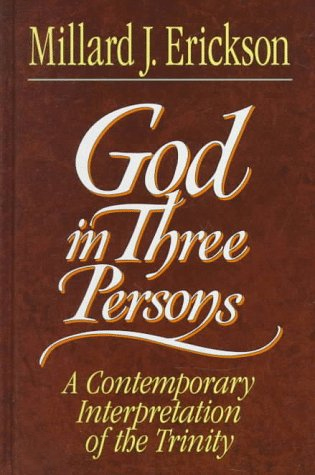This afternoon I finished reading the entirety of God in Three Persons: A Contemporary Interpretation of the Trinity (342-pages). The whole effort was time well spent because it concerns the doctrine of the Trinity upon which various other doctrines rest. The book was a comprehensive look at the doctrine and the Trinity itself from the author (Millard Erickson, 1995) yet from the perspectives of various 18th, 19th, and 20th-century theologies as well. Moreover, the scope of the book covered the councils of Nicea (325 A.D.) and Constantinople (381 A.D.) to assert the relevance and consequences of the doctrine, including the safety and survival of Rome.1
While the book thoroughly covers the history of the doctrine’s development and its interpretive approaches, it highlights with careful attention the importance of what it is and what it does. The well-known and highly influential German theologian Wolfhart Pannenberg (1923-2014) asserted without hesitation that the doctrine of the Trinity is the most important among all doctrines by comparison. With numerous historical citations involving early church patristics, Erickson traverses the formulaic development of the doctrines from the first through fourth centuries. The apostolic fathers, Irenaeus, Hippolytus, Tertullian, Origen, and Athanasius formed instruction and traditions around the doctrine to counter opposing thoughts and assertions about the triadic form of God. Furthermore, over decades, modalism, tri-theism, Arianism, and other disputes concerned the developing church where the formation of the doctrine of the Trinity had to become a priority to settle.
From the earliest understanding of authoritative and inspired Scripture, the biblical meaning of the doctrine appeared on a scale. A valid and necessary interpretation of the Trinity was at rest on a sort of conceptual fulcrum on a scale. Move too much one way in understanding and interpretation slides to a form of modalism (liberation theology & feminism), move in the opposite direction on the scale, and interpretation moves to tri-theism, or Arianism. While tri-theism tends to be an errant way of thinking about the Trinity today, Arianism purported that Jesus could not have been truly God. The teaching of Arius (335/336 A.D.) was deemed heretical at the council of Nicea in 325 A.D.
Erickson enumerates the numerous passages that biblically reference the doctrine of the Trinity from the Old to New Testaments. Historical and cultural narratives concerning the nature and triadic unity of God across Old Testament covenants involved God’s interaction with individuals, groups, tribes, and nations. To further extend the presence of God as triune in the New Testament, numerous gospel and Pauline references point to the truth of God’s Being as Father, Son, and Holy Spirit as separate yet One. The various triadic passages and references within Pauline writings and the baptismal formula set the doctrine’s foundation to assure interpreted revelation for humanity to recognize God as He is.
To further narrow the meaning of the triadic union of God, the gospel of John makes extensive reference to the relationship between all members of the Trinity. In contrast to the Old Testament, the members of the Trinity are identified explicitly to indicate their function, momentary subordination, incarnation, and the relationship between each other and humanity. Taken together, the compiled meaning of God’s identity as revealed in Scripture is nothing short of astonishing and profound. The testimony of Old and New Testament witnesses to God, His activity, and work through the patriarchs, prophets, and apostles made a punctuated and alarming impression about reality beyond day-to-day recognition that is certain to last until the Parousia.
As Greek and Latin recognition of the revelatory witness began, numerous approaches to the understanding of the Trinity ensued. Philosophical assertions about the metaphysical nature of Trinitarian theology took shape from early Greek thought to more scholastic and postmodern perspectives. Erickson does an exceptional job outlining the substance of various contributors to philosophical and theological engagement. From Aquinas and Kant to Schleiermacher, Barth, Rahner, and more contemporary contributors of Henry, Davis, and Lacugna, different competing perspectives are presented, emphasizing a process of elimination given biblically grounded rationale. Tradition, utilitarian, or social preferences carried no interpretive weight with the author.
To make a case for the understanding and correct interpretation of the doctrine of the Trinity, the author covers various objections to the Trinity in painstaking detail. Moreover, the author effectively argues for the necessity of instruction on the doctrine as a matter of pressing discipleship or catechesis. A proper understanding and interpretation of the doctrine are foundational and practical as it concerns prayer life, worship, apologetical contention, interpersonal relationships, and church governance. The doctrine of the Trinity is such a crucial area of instruction that it affects the future health and development of the Church and Christianity in general.
[1] Erickson cites on page 13: Adolf Harnack, History of Dogma (New York: Dover, 1961), 4:60–67.














Comments are closed.